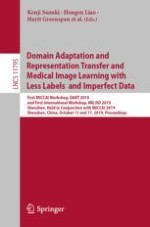2019 | OriginalPaper | Chapter
Improving Pathological Structure Segmentation via Transfer Learning Across Diseases
Authors : Barleen Kaur, Paul Lemaître, Raghav Mehta, Nazanin Mohammadi Sepahvand, Doina Precup, Douglas Arnold, Tal Arbel
Published in: Domain Adaptation and Representation Transfer and Medical Image Learning with Less Labels and Imperfect Data
Publisher: Springer International Publishing
Activate our intelligent search to find suitable subject content or patents.
Select sections of text to find matching patents with Artificial Intelligence. powered by
Select sections of text to find additional relevant content using AI-assisted search. powered by
